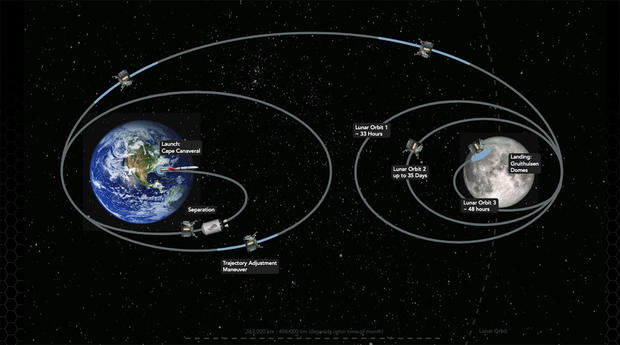New Vulcan rocket blasts off on maiden flight carrying privately built robotic moon lander
Update: Astrobotic said its moon lander ran into problems staying properly oriented; read the latest here. Our earlier story is below.
For the first time in more than 50 years, a commercially built American lander was fired off to the moon early Monday, a small robotic probe called Peregrine that's packed with 20 experiments and international payloads, including five NASA science instruments and a sensor valued at $108 million.
Other payloads include university experiments, a collection of Mexican and U.S. micro rovers, artwork, compact time capsules, a bitcoin and even a small collection of human "cremains" provided by two companies that offer memorial flights to space.
While the Peregrine lander, built by Pittsburgh-based Astrobotic, was the mission's showcase payload, its ride to space was equally important, if not moreso: the long-awaited maiden flight of United Launch Alliance's new Vulcan rocket, a heavy-lift booster that's replacing the company's workhorse Atlas and Delta family of launchers.
After a surprisingly problem-free countdown, the Vulcan's two methane-burning BE-4 engines and twin solid-propellant strap-on boosters thundered to life at 2:18 a.m. EST, lighting up the deep overnight sky with a brilliant burst of fire and billowing clouds of exhaust.
The 198-foot-tall, 1.5-million-pound rocket majestically climbed skyward from launch complex 41 at the Cape Canaveral Space Force Station atop two million pounds of thrust, quickly arcing away to the east over the Atlantic Ocean in a sky-lighting spectacle visible across central Florida
The Vulcan and Centaur upper stage chalked up an apparently flawless climb to space and 50 minutes after liftoff, the Peregrine lander was released to fly on its own. A few minutes later, Astrobotic engineers reported they were receiving telemetry from the spacecraft.
For the next 18 days or so, Peregrine will remain in a highly elliptical Earth orbit before firing its thrusters to head for the moon. The trajectory was planned to set up a daylight landing near an enigmatic volcanic feature known as the Gruithuisen Domes. Allowing time for tests and checkout, Peregrine is expected to begin its hourlong descent to the surface on Feb. 23.
"It's hard to put into words how excited Astrobotic is for making this first mission back to the surface of the Moon since Apollo," said CEO John Thornton. "This is a moment 16 years in the making. We've had to overcome a lot along the way, a lot of doubt.
"When we started in Pittsburgh, the idea of building a space company, much less one to go to the moon, was completely foreign and alien, and folks literally laughed at the concept. But 16 years later ... here we are on the launch pad."
Along with adding a powerful new rocket to the U.S. inventory, the launch was the first in a series of private-sector moon missions funded under a NASA program intended to spur development of commercial lunar transportation and surface delivery services.
NASA's Commercial Lunar Payload Services program or CLPS, "will usher in not only great new science for NASA in the United States, but the first test of this new model where it's not NASA's mission, NASA is being carried to the surface of the moon as part of a commercial mission with a commercial launch vehicle," said Joel Kearns, a senior CLPS manager.
As for the Vulcan, Mark Peller, ULA's vice president of Vulcan development, said "it's the future of our company."
"The system that we've developed is really positioning us for a very bright, prosperous future for many, many years to come," he said. "It has proven to already be an extremely competitive product in the marketplace, having an order book of over 70 missions before first flight."
Replacing the company's expensive Delta 4 and workhorse Atlas 5 rocket, which uses Russian RD-180 Russian engines, the Vulcan relies on two BE-4 first stage engines built by Blue Origin, the space company owned by Amazon founder Jeff Bezos.
At liftoff, the twin BE-4s generate 1.1 million pounds of thrust. Two Northrop Grumman strap-on solid-propellant boosters, or SRBs, generate another 919,200 pounds of push, providing a total thrust of just over 2 million pounds. The Vulcan can be launched with up to six strap ons depending on mission requirements.
The new rocket also features a more powerful hydrogen-fueled Centaur upper stage with two Aerojet Rocketdyne RL10C engines capable of boosting heavy military payloads into so-called high-energy orbits that can't be easily reached by rockets optimized for low-Earth orbit.
"No one in the world still designs a high-energy-optimized rocket," ULA CEO Tory Bruno told a small group of reporters at the launch pad Saturday. "That market has been abandoned by the commercial providers because it's less expensive (and) less risky to develop rockets designed for LEO (low-Earth orbit) operations."
"Not only is it very, very capable, it's also less expensive," he added, saying a Vulcan costs about one third the price of a Delta 4 Heavy.
SpaceX now dominates the commercial launch marketplace, firing off a record 96 Falcon 9 and Falcon Heavy flights last year, not counting two partially successful test flights of the company's new Super Heavy-Starship. Sixty three of the Falcons launched in 2023 were used to put the company's Starlink internet satellites into orbit.
Peller said the Vulcan is an "extremely good value and is very competitive in the marketplace."
"What's unique about Vulcan, and what we originally set out to do, was to provide a rocket that had all the capabilities of Atlas and Delta in one single system," he said. "And we achieved that in a vehicle that has performance that's even greater than the three-body Delta 4 Heavy.
"What we've been able to achieve is a vehicle that goes all the way from medium to heavy lift in a single core configuration. Unlike Delta 4 (and) some of our competitors, where they have to use three-body configuration vehicles for heavy lift, Vulcan can do that all in a single core."
As for SpaceX's gargantuan Super Heavy-Starship, Bruno called it "an extreme example of a LEO-optimized rocket. So a veritable freight train to LEO. I mean, I'll be straight with you guys, a Starship, when successfully fielded, will carry four times the mass that (Vulcan) can carry to LEO."
But he said the fully reusable Starship uses all its fuel just to reach low-Earth orbit. "That's why they talk about on-orbit refueling because it's dry once it gets there," he said, adding, "it'll be an excellent platform for carrying Starlinks."
Maiden flights typically feature small, relatively inconsequential payloads because of presumably higher risks. But Astrobotic opted to put Peregrine atop the first Vulcan because of ULA's long history, its record of successful launches and because the Vulcan, other than the BE-4 engines, is essentially an upgraded version of the flight-proven Atlas 5.
"We chose United Launch Alliance as first flight of Vulcan because we believe so much in the company, and we're very, very confident that this mission will be successful," Thornton said. "And of course, that came with some relief on the price, and that makes this mission possible."
Only the United States, Russia, China and India have successfully put landers on the surface of the moon. If successful, Peregrine will be the first U.S. lander to reach the moon's surface since the Apollo 17 mission in 1972, the first privately developed American lander and only the third overall.
Two privately funded moon landers, one from Israel and the other from Japan, crashed during landing attempts in 2019 and 2023 respectively.
Peregrine is designed to serve as a lunar delivery vehicle, carrying payloads from governments, universities, nonprofits and even individuals to the surface of the moon. Astrobotic's website says the cost to put a payload into orbit around the moon is $300,000 per kilogram (2.2 pounds). The price for a landing is $1.2 million per kilogram.
NASA put five sophisticated instruments on Peregrine Mission 1, along with a space navigation sensor. The agency's total investment in the mission is $108 million.
Other payloads include five micro rovers provided by Mexico, an experimental Astrobotic navigation sensor, a Japanese time capsule with messages from more than 185,000 children, bitcoins, a small rover from Carnegie Mellon University, commemorative plaques and a DHL "Moonbox" containing a variety of mementos, including a tiny rock from Mount Everest.
Also on board: samples of cremated remains provided by Celestis and Elysium Space, companies that offer to send small amounts of ashes of loved ones into space as memorials.
The president of the Navajo Nation recently told NASA the presence of human remains of any sort aboard spacecraft landing on the moon amounts to desecration of a celestial body that is "revered by our people." NASA officials said they were willing to discuss the concerns, but the Peregrine launch was expected to proceed as planned.
"I've been disappointed that this conversation came up so late in the game, I would have liked to have this conversation a long time ago," Thornton said. "We announced the first payload manifest of this nature back in 2015, a second in 2020. We really are trying to do the right thing, and I hope we can find a good path forward with Navajo Nation."






